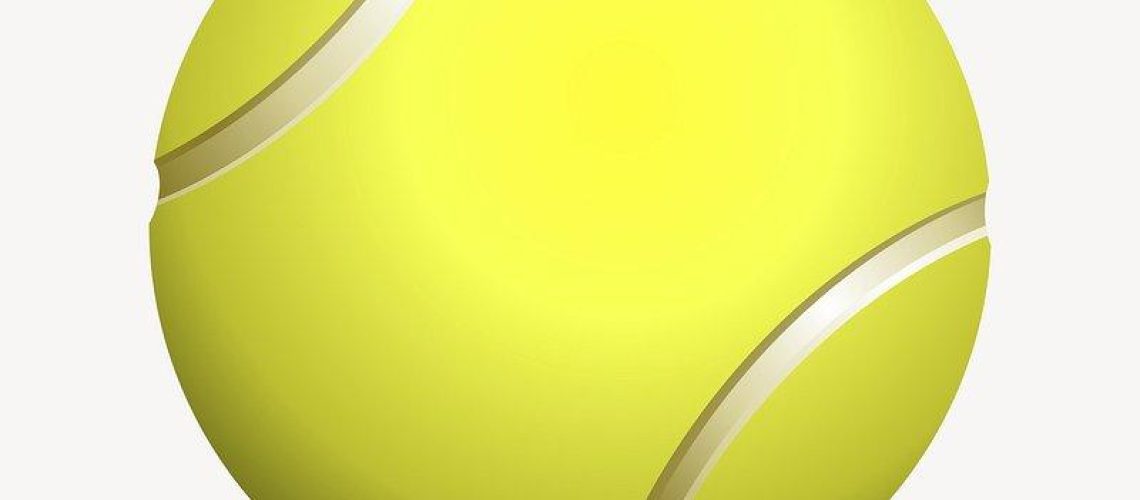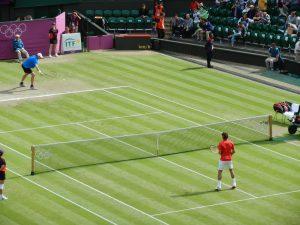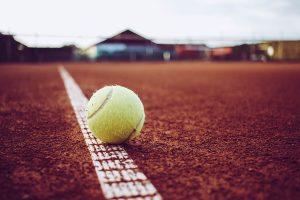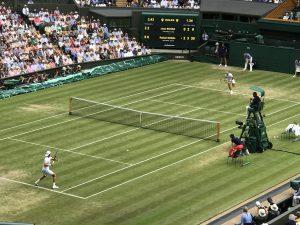We may earn money or products from the companies mentioned in this post.
Brief Overview of Tennis Ball Bounce and its Importance in the Sport

When you think of tennis, one of the first things that comes to mind is the rhythmic sound of a ball bouncing on the court The bounce of a tennis ball plays a crucial role in the sport, affecting the pace, spin, and overall dynamics of the game
The Role of Air Pressure and Rubber Material in Tennis Ball Bounce
Have you ever wondered what makes a tennis ball bounce? Two key factors come into play – air pressure and rubber material Inside a tennis ball, there is pressurized air that gives it its characteristic bounce The higher the air pressure inside, the more lively and responsive the ball will be when it hits the ground
Additionally, the rubber material used in manufacturing tennis balls contributes to their bounce The rubber provides elasticity and resilience, allowing for efficient energy transfer upon impact with the court surface This combination of air pressure and rubber material creates a predictable and consistent bounce
Tennis Ball Specifications Set by International Tennis Federation (ITF)
To ensure fair play across all levels of competition, the International Tennis Federation (ITF) has established specific regulations for tennis balls These specifications include guidelines for size, weight, deformation, and bounce height By adhering to these standards, players can expect uniformity in how balls behave during matches
Factors Influencing a Tennis Ball’s Bounce Over Time

Usage Frequency
The more a tennis ball is used during practice sessions or matches, the more its performance may change over time Each time a ball is struck with force or rubbed against rough surfaces like clay courts or hard concrete walls, it undergoes wear and tear As a result, its bounce may gradually decrease, leading to a less lively game experience Regularly replacing tennis balls is essential to maintain consistent playability
Storage Conditions
Proper storage of tennis balls is another crucial factor affecting their bounce Exposure to extreme temperatures, such as excessive heat or cold, can alter the air pressure inside the ball and affect its resilience Additionally, storing balls in a humid environment can lead to moisture absorption, making them heavier and less bouncy To preserve the optimal bounce of tennis balls, it’s recommended to store them in a cool and dry place
With these insights into tennis ball bounce and the factors that influence it over time, players can be better equipped to understand the nuances of this essential element in the sport
What causes a tennis ball to lose its bounce?

Tennis balls are designed to provide optimal bounce during gameplay, but over time, they can lose their lively bounce Several factors contribute to this phenomenon, including internal air pressure loss, breakdown of the rubber material within the ball, and the impact of court surface type
Internal air pressure loss
One of the main reasons for a tennis ball losing its bounce is internal air pressure loss Tennis balls are pressurized with air to maintain their shape and elasticity However, factors such as manufacturing imperfections or damage from play can lead to air leakage
-
Manufacturing imperfections:
During the production process, some tennis balls may have small defects that allow air to escape gradually -
Damage from play:
Continuous use and impact on hard surfaces can cause wear and tear on a tennis ball’s exterior Punctures or tears in the outer covering can lead to air leakage as well
Breakdown of the rubber material within the ball
The rubber material inside a tennis ball plays a crucial role in its ability to bounce Over time, this rubber can break down due to various factors, affecting its elasticity and rebound capacity
-
Effects of temperature:
Temperature extremes can significantly impact a tennis ball’s performance Cold temperatures tend to decrease bounce height as rubber becomes less flexible On the other hand, warm temperatures soften the rubber material, leading to reduced energy return upon impact with the racket or court surface
Impact of court surface type on tennis ball wear and tear
The type of court surface where tennis is played also influences how quickly a tennis ball loses its bounce Different court surfaces, such as hard courts, clay courts, and grass courts, have unique characteristics that affect the wear and tear on the ball
-
Differences between hard courts:
Hard court surfaces, like concrete or asphalt, are relatively unforgiving and can cause more abrasion on the outer covering of a tennis ball This increased friction can contribute to quicker loss of bounce -
Clay courts:
Clay courts provide more cushioning and reduce the impact on tennis balls As a result, they tend to retain their bounce for longer compared to hard courts -
Grass courts:
Grass courts offer a faster playing surface but can be harsh on tennis balls due to their uneven nature The constant sliding and contact with grass can accelerate wear and tear
In conclusion, multiple factors contribute to why tennis balls lose their bounce over time Internal air pressure loss, breakdown of rubber material within the ball, and the type of court surface all play significant roles in determining how long a tennis ball maintains its lively rebound characteristics during gameplay
How quickly does a tennis ball lose its bounce?

Tennis balls are an integral part of the game, and their bounce plays a crucial role in determining the pace and dynamics of each match However, over time, tennis balls inevitably lose their bounce due to wear and tear Let’s explore the factors that influence how quickly this happens
Typical lifespan of various types of tennis balls
Not all tennis balls are created equal when it comes to durability Regular duty balls, designed for use on clay or indoor courts, tend to have a shorter lifespan compared to extra duty balls used on hard courts The rougher surface of hard courts can cause more friction and wear down the ball’s felt covering faster
In addition to court type, whether a tennis ball is pressurized or non-pressurized also affects its longevity Pressurized balls have an internal pressure that helps maintain their bounce for longer periods Non-pressurized balls, on the other hand, rely solely on the quality of their construction materials
On average, a well-maintained pressurized regular duty ball can last around 4-6 games before experiencing significant bounce loss Extra duty pressurized balls may hold up for 10-12 games before showing noticeable signs of deterioration Non-pressurized balls typically have a shorter lifespan and may start losing bounce after just 1-2 games
Impact of usage patterns on rate of degradation
The rate at which tennis balls lose their bounce can also be influenced by usage patterns Casual players who engage in occasional recreational matches will generally experience slower degradation compared to professional players who compete regularly at higher intensities
Playing frequency is another crucial factor Tennis balls that are used frequently tend to lose their bounce faster than those used sparingly The constant impact and friction during gameplay gradually compress the internal air, causing the ball to become less lively over time
So, how quickly does a tennis ball lose its bounce? The answer depends on various factors such as court type, ball type, pressurization, usage patterns, and playing frequency By understanding these elements, players can make informed decisions about when to replace their tennis balls to maintain optimal performance on the court
How to Maintain the Lifespan and Preserve the Bounce Quality of Your Tennis Balls

When it comes to your tennis game, having fresh and bouncy balls can make all the difference To ensure that your tennis balls last longer and maintain their bounce quality, here are some valuable tips:
Proper Storage Techniques for Unused or Lightly Used Balls
1 Storing them in sealed, pressurized containers or original packaging: Keeping your tennis balls in airtight containers or their original packaging can help preserve their internal pressure, preventing them from losing their bounce over time
2 Avoiding extreme temperature fluctuations during storage: Extreme temperatures can have a detrimental effect on the elasticity of tennis balls It’s important to store them in a cool and dry place, away from direct sunlight or freezing conditions
Replacing Worn-out or Damaged Balls Regularly During Matches
1 Recognizing signs of wear in the ball’s felt cover and bounce quality: As you play with your tennis balls, they will naturally experience wear and tear Keep an eye out for visible signs of damage such as frayed felt covers or significant loss of bounce When these signs become apparent, it’s time to replace them with new ones
Considering the Use of Non-Pressurized or Pressureless Tennis Balls for Practice Sessions
1 Advantages and disadvantages compared to traditional pressurized balls: Non-pressurized or pressureless tennis balls offer certain advantages when it comes to practice sessions They have a longer lifespan since they don’t rely on internal air pressure for their bounce However, they might feel slightly different compared to traditional pressurized balls
2 Longevity and performance characteristics: Pressureless balls are known for their durability and consistency They maintain their bounce throughout extended practice sessions, making them ideal for drills and training exercises
By following these guidelines, you can extend the life span of your tennis balls and ensure that they retain their bounce quality Proper storage techniques, regular replacement of worn-out balls, and considering non-pressurized options for practice sessions will all contribute to an improved tennis experience on the court
Conclusion

Recap of factors influencing a tennis ball’s bounce loss and lifespan
In conclusion, there are several factors that can influence the bounce loss and lifespan of a tennis ball The primary factor is the quality of the rubber core within the ball Higher-quality cores tend to have better durability and retain their bounce for a longer period of time Additionally, external factors such as playing surface, temperature, humidity, and frequency of use can also impact the ball’s performance over time
Importance of proper care, usage, and storage to maintain optimal performance
To ensure optimal performance and longevity of tennis balls, proper care, usage, and storage are essential After each use, it is recommended to clean off any dirt or debris from the balls using a damp cloth or towel It is also advisable to rotate your tennis balls regularly during play to distribute wear evenly across all of them
When not in use, storing your tennis balls in a cool and dry place can help prevent them from losing their bounce prematurely Avoid exposing them to extreme temperatures or direct sunlight for extended periods as this can degrade the rubber core
Encouragement to remain vigilant about ball condition during play for the best tennis experience
Lastly, it is crucial for players to remain vigilant about the condition of their tennis balls during play Regularly inspecting the balls for signs of wear or damage can help identify when they need replacement As soon as you notice significant loss of bounce or visible deterioration in your tennis balls, it is recommended to replace them with new ones to maintain an enjoyable playing experience
By taking these steps and being proactive in caring for your tennis balls, you can maximize their lifespan and ensure consistent performance on the court
Useful Links

How Quickly Does A Tennis Ball Lose Its Bounce?
How many times does a tennis ball bounce from a height …
Close encounters of the gravitational kind …
Tennis ball
Ball Testing
The Physics of Tennis | Ball Spin During Bounce
Why Does A Tennis Ball Bounce
How Long Do Tennis Balls Last? [2023 Updated]
Do Fresh Balls Bounce Better?
Why Do Tennis Balls Go Flat? – The Racket Life
How Long Do Tennis Balls Last? (in the can & after opening)
Potential Energy: The Study of a Bouncing Tennis Ball
Why Do Tennis Balls Lose Pressure?
What is a Lifetime Supply of Tennis Balls?
How long do tennis balls last?
That’s the Way the Ball Bounces (two)
How Long Do Tennis Balls Last?






